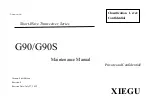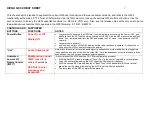
7
Circuit Description
Receive Signal Path
Incoming RF signal is from the antenna jack is de-
livered to the Main Unit and passed through the low-
pass filter network consisting capacitors C1213,
C1236, C1239, & C1241 and coils L1017, L1018, &
L1019, antenna switching diode
D1020
and
D1028
(both
RLS135
), and varactor-tuned band-pass filter
consisting of capacitors C1248, C1249, C1250, C1251,
C1252, & C1268, coils L1020, L1021, & L1024, and
diodes
D1024
and
D1025
(both
HVC350B
), before
delivery to the RF amplifier
Q1045
(
3SK296ZQ
). The
amplified RF signal is passed through the another
varactor-tuned band-pass filter consisting of capac-
itors C1198, 1199, 1200, & 1218, coils L1012 and L1015,
and diodes
D1017
and
D1021
(both
HVC350B
), then
applied to the 1st mixer
Q1037
(
3SK296ZQ
) along
with the first local signal from the PLL circuit.
The first local signal is generated between 114.3 MHz
and 152.3 MHz by the VCO, which consists of
Q1009
(
2SC5231
) and varactor diode
D1002
(
HVC350B
)
according to the receiving frequency.
IF and Audio Circuits
The 21.7 MHz first IF signal is applied to the mono-
lithic crystal filters
XF1001
and
XF1002
which strip
away unwanted mixer products, and the IF signal is
applied to the first IF amplifier
Q1032
(
2SC4400
).
The amplified first IF signal is then delivered to the
FM IF subsystem IC
Q1028
(
NJM2591V
), which con-
tains the second mixer, limiter amplifier, noise am-
plifier, and FM detector.
The second local signal is generated by 21.25 MHz
crystal
X1001
, produces the 450 kHz second IF sig-
nal when mixed with first IF signal within
Q1028
(
NJM2591V
).
The 450 kHz second IF signal is applied to the ce-
ramic filter
CF1001
(for Narrow FM) or
CF1002
(for
Wide FM) which strip away unwanted mixer prod-
ucts to the ceramic discriminator
CD1001
which re-
moves any amplitude variations in the 450 kHz IF
signal before detection of speech.
The detected audio from the
Q1028
(
NJM2591V
)
passes through the de-emphasis circuit consisting
of resistors R1082 & R1113, and capacitors C1120 &
C1122, to the audio mute gate
Q1034
(
2SJ364
)
The audio signal passes through a band-pass filter
consisting of
Q1046
and
Q1047
(both
2SC4154
), and
the audio mute gate
Q1039
(
2SJ347
), to the audio
VR which adjusts the audio sensitivity to compen-
sate for audio level variations. The adjusted audio
signal is delivered to the audio amplifier
Q1035
(
LA4425A
) which provides up to 3 Watts, to the ex-
ternal speaker jack or a 4-Ohm loudspeaker.
Squelch Control
When no carrier received, the noise signal from
Q1028
(
NJM2591V
) is amplified by
Q1051
(
2SC4617
), and is detected by
D1011
and D1013
(both
DA221
). The resulting DC voltage passes
through the SQL knob to main CPU
Q2002
(
HD64F2266TF13
). While no carrier is received,
main CPU
Q2002
(
HD64F2266TF13
) control
Q1048
(
CD4094BPWR
), thus, audio mute gate
Q1034
(
2SJ364
) and
Q1039
(
2SJ347
) turns “OFF” to dis-
able the audio output from the speaker.
Transmit Signal Path
The speech signal from the microphone is amplified
by
Q1049
(
LA2902PWR
). The amplified speech sig-
nal is subjected to the low-pass filter network
Q1049
(
LA2902PWR
) to deviation controlled by
Q1043
(
M62364FP
).
The adjusted speech signal from
Q1043
(
M62364FP
)
is delivered to VCO
Q1009
(
2SC5231
) which fre-
quency modulates the transmitting VCO made up
of
D1004
(
HSC277
).
The modulated transmit signal passes through buff-
er amplifier
Q1010
and
Q1023
(both
2SC5374
).
The transmit signal applied to the drive amplifier
Q1026
(
2SC5226
), then finally amplified by power
amplifier module
Q1030
(
RA60H1317M
) up to 50
Watts. The APC circuit controls the
Q1030
(
RA60H1317M
) power amplifier’s gain.
The 50 Watts RF signal passes through low-pass fil-
ter network consisting of Capacitors C1210 and
C1211 and coil L1013, antenna switch
D1018
and
D1019
(both
XB15A709
), and another low-pass fil-
ter network consisting capacitors C1213, C1236,
C1239, & C1241 and coils L1017, L1018, & L1019, and
then deliver to the ANT jack.
Summary of Contents for FT-1900R
Page 4: ...4 Note...
Page 5: ...5 Block Diagram...
Page 6: ...6 Connection Diagram...
Page 14: ...14 MAIN Unit Note...
Page 26: ...26 MAIN Unit Note...
Page 32: ...32 Note CNTL Unit...
Page 33: ...33...








































